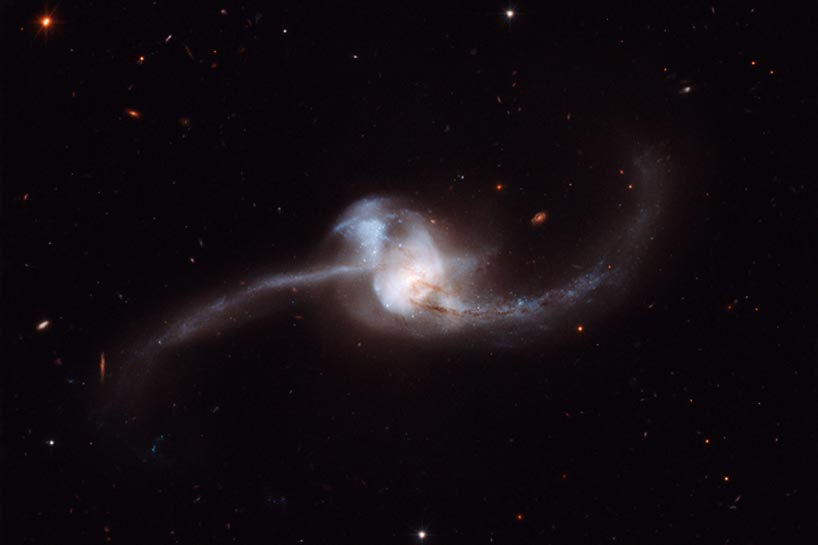
Interacting Galaxy
RA 8h 38m 24.11s Dec 25° 45' 15.25"
Cancer
300 million light years
13.4
2.4 by 0.7 arcmin
2.83 x 1.96 arcminutes
North is 134.8° right of vertical
NASA, ESA and A. Evans (Stony Brook University, New York, U of Virginia & National Radio Astronomy Observatory, Charlottesville, USA)
October 13, 2009
2017 image: G1742
ABOUT THIS IMAGE:
A recent NASA/ESA Hubble Space Telescope image captures what appears to be one very bright and bizarre galaxy, but is actually the result of a pair of spiral galaxies that resemble our own Milky Way smashing together at breakneck speeds. The product of this dramatic collision, called NGC 2623, or Arp 243, is about 250 million light-years away in the constellation of Cancer (the Crab).
Not surprisingly, interacting galaxies have a dramatic effect on each other. Studies have revealed that as galaxies approach one another massive amounts of gas are pulled from each galaxy towards the center of the other, until ultimately, the two merge into one massive galaxy. The object in the image, NGC 2623, is in the late stages of the merging process with the centers of the original galaxy pair now merged into one nucleus. However, stretching out from the center are two tidal tails of young stars showing that a merger has taken place. During such a collision, the dramatic exchange of mass and gases initiates star formation, seen here in both the tails.
The prominent lower tail is richly populated with bright star clusters — 100 of them have been found in these observations. The large star clusters that the team have observed in the merged galaxy are brighter than the brightest clusters we see in our own vicinity. These star clusters may have formed as part of a loop of stretched material associated with the northern tail, or they may have formed from debris falling back onto the nucleus. In addition to this active star-forming region, both galactic arms harbor very young stars in the early stages of their evolutionary journey.
Some mergers (including NGC 2623) can result in an active galactic nucleus, where one of the supermassive black holes found at the centers of the two original galaxies is stirred into action. Matter is pulled toward the black hole, forming an accretion disc. The energy released by the frenzied motion heats up the disc, causing it to emit across a wide swath of the electromagnetic spectrum.
NGC 2623 was discovered by Édouard Stephan on January 19, 1885.
NGC 2623 is so bright in the infrared that it belongs to the group of very luminous infrared galaxies (LIRG) and has been extensively studied as the part of the Great Observatories All-sky LIRG Survey (GOALS) project that combines data from some of the most advanced space-based telescopes, including Hubble. Additional data from infrared and X-ray telescopes can further characterize objects like active galactic nuclei and nuclear star formation by revealing what is unseen at visible wavelengths.
The
GOALS project includes data from NASA/ESA's Hubble Space Telescope, NASA's
Spitzer Space Telescope, NASA's Chandra X-ray Observatory and NASA's Galaxy
Evolution Explorer (GALEX). The joint efforts of these powerful observing
facilities have provided a clearer picture of our local Universe. The
data used for this color composite were taken in 2007 by the Advanced
Camera for Surveys (ACS) aboard Hubble.